World Dream Bank
home -
add a dream -
newest -
art gallery -
sampler -
dreams by
title,
subject,
author,
date,
places,
names
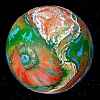
 THARN
THARN
by Chris Wayan, 2005-9
This one's for Marcia Pagels: you already have your oxygen mask
Map, Peoples of Tharn, Regional tours, Geology and Evolution, gazetteer, terms explained. More worlds? Planetocopia!
INTRODUCTION
Tharn's an experimental model--a challenge to exobiologists like Peter Ward Douglas ("Rare Earth" and other books) who claim complex life will only evolve on the few planets almost exactly like ours. Tharn is emphatically not Earth: small, very dry, thin-aired--like a thawed-out Mars. How poor can a world get, and still have life? Life worth living? To my surprise, Tharn turned out to be not just viable, but three worlds in one:
- Craters and rifts like our ocean trenches. Almost earthlike air. Life flourishes, much of it winged. Examples: Heloon Crater, Mrr Trench
- Plains like our seabasins, with Himalayan air. Where there's water, there's life. Examples: Barsoom Basin, the South Seas
- "Continental" uplands and mountain chains. Stratospheric air. Martian, but warmer valleys hold life. Examples: Thuvia Upland, the Chinchaks
Tharn isn't even a planet, but a mere moon of a super-Jupiter. Douglas argues that gas giants close to their suns will sweep all the Earthlike worlds out of the system. But so what? Since these new hot giants are often bigger than Jupiter, some of their moons will be oversize too--Martian, even Terran! Big enough to be biospheres. As a class, let's call them airmoons. Douglas isn't alone in omitting such moons; it's common among exobiologists to write off all systems with close-in gas giants. Even science fiction habitually invents alien planets--only a handful of moons are portrayed as living worlds. So let's put this class of moons (moons with class!) center stage. Welcome to...
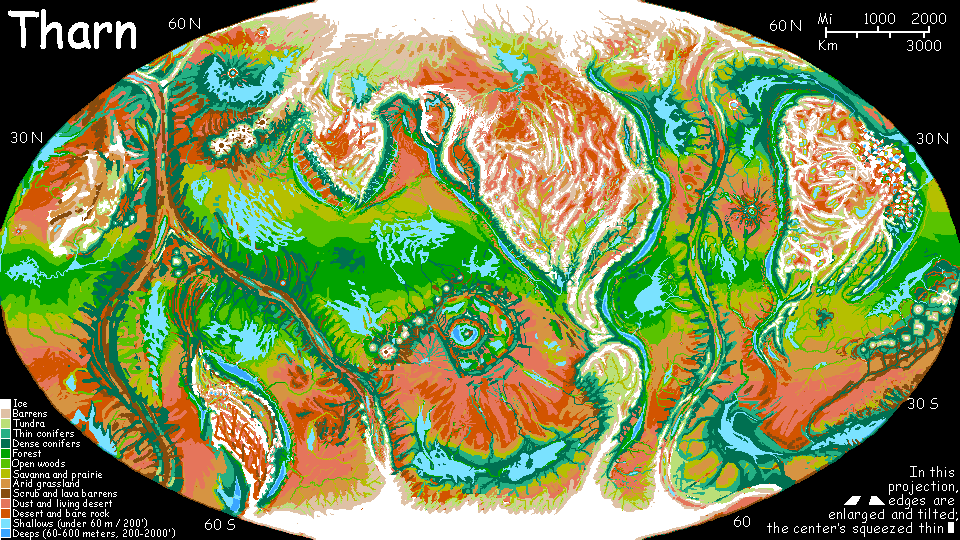 THARN: BASICS
THARN: BASICS
-
World-type = airmoon (a moon with an atmosphere dense enough to permit surface liquids: seas, rivers, rain). We know of only one airmoon--Titan, which happens to be cold and dry. Tharn is dry too, but much warmer. Other airmoons will be much wetter. Example: Pegasia
-
Sun = smaller, redder, and cooler than Sol--and much commoner! Most exobiologists focus on sunlike stars. They assume Earths orbiting small stars will have to huddle so close for warmth that solar tides would slow their spin till they're locked facing the sun--burning dayside, freezing nightside. But what about moons? Their biggest tidal influence is their planet, not the sun, so they often end up facing their primary--and spinning relative to the sun, even if it's close. Tharn (and its big sister Pegasia) are such moons. Even if only a few red stars have viable moons, I suspect they outnumber the Earths out there! Because little red stars are common as dirt.
-
Orbit = elliptical, from 0.4 to 0.7 AU (a bit over half as far out as Earth, on average). Why elliptical? Well, lots of gas giants appear to be eccentric, and worlds in such orbits are commonly written off as unfriendly to life. But are they? Temperature variations make life harder if conditions were already ideal, but on Earth, the seasons make many regions habitable--think of polar summers and subtropical monsoons. Orbital seasons (within reason) probably improve the overall odds for life. Tharn's year has a short hot worldwide summer, then a long cool worldwide winter (the outer half of an elliptical orbit is slower--takes up more of the year).
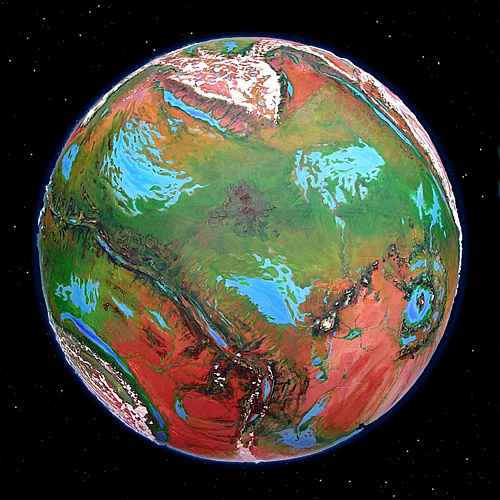
-
Total annual insolation = 86% of Earth's. Sounds chilly, but it's twice Mars (44%). In fact, much of Tharn's as warm as Earth, because its air, though thin, is rich in greenhouse gasses. See CO2 and TEMPERATURE below.
-
Axial tilt = 16 degrees, relative to the sun--nearly the same as the tilt of its orbit around its gas-giant primary, Zeus.
-
Ultraviolet levels = moderate. Tharn's thin air blocks UV poorly, but its cool red sun produces much less.
-
Radiation levels = fairly high. The magnetic field of huge Zeus, around which Tharn orbits, creates arcs like the one linking Io and Jupiter (though much weaker); the surfaces of Tharn's inner neighbors crackle with static electricity and suffer a rain of charged particles. Barren little Galilea (smaller than Io, but just as savagely volcanic) takes the brunt of it, but even the next moon out, Pegasia, has constant auroras and a rain of high-energy ions on its leading face. Only its very dense air and native magnetic field shield it enough so life is possible. Tharn, much further out, is poorly shielded but quieter.
-
Solar year = 7 months? Shorter than Earth's year, certainly. I'm being vague because I haven't looked up the curve for light vs mass of Zeus's sun yet, and the mass determines the year-length. Just keeping some wiggle room!
-
Seasons = strong and worldwide. Tharn's eccentric orbit creates global warm and cool seasons. This means the equatorial belt is more seasonal than Terra's. During global winter, "rainforests" are warm to mild with light rains; in the summer, hot and torrential. Quite monsoonish! The high latitudes, too, have stronger seasons than Earth, particularly the northern hemisphere, whose axial and orbital summers roughly coincide. Life creeps a little nearer the north pole--despite the harsher winters, arctic summers thaw more tundra, giving grass and lichens a brief growing season. The south has wider barrens.
-
Mass = 0.25 Earths. If that sounds tiny, consider: it's more than Mars, Titan, Io, Europa, Ganymede, and Callisto combined. In fact, toss in all the other moons in the solar system, too--you'll still barely equal Tharn.

-
Density = 5 gm/ml, like Earth or Venus. Therefore, Tharn probably formed here in the inner system, and got captured when Zeus spiraled in. Tharn's an ex-planet! Its big sister Pegasia is far less dense and hugs Zeus, so it's probably a true moon that formed in the outer system along with Zeus.
-
Diameter = 8300 km (5200 mi): 65% of Earth's, 22% bigger than Mars. Circumference is about 26,100 km (16,300 mi). A degree's about 72 km (45 mi); the thirty-degree lines on the map are 2175 km apart (1360 mi).
-
Surface area = 216 million sq km (83.5 M sq mi), just 42.5% of Earth's surface.
-
Gravity = 0.59 G (Earth=1, Mars 0.38)
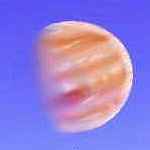
-
Primary (the planet Tharn orbits) = Zeus, a gas giant 200,000 km across (125,000 mi), nearly 50% wider than Jupiter and nearly twice its mass (600 Earths). Its heat puffs it up to only 2/3 Jupiter's density.
-
Tharn orbits Zeus 1.18 million km out (733,000 mi), over three times as far as Luna is from Earth.
-
Day = about 48 hours. Tharn isn't fully tidelocked (one side facing Zeus, as Luna faces Earth) but it spins slowly--just three times during each rather eccentric orbit (six Earth days). That's no coincidence--it's a harmonic, like Mercury's day. The 48-hour day is also close to the period of Tharn's inner neighbor Pegasia, which is tidelocked. Again, no coincidence; Pegasia swings nearest to Tharn every six days, close to the same point in their orbits. This resonance may have stabilized Tharn's orbit and spin. Let's hope so; an even longer day could get pretty harsh. I know, you'd think Tharn would be fully tidelocked or tossed right out of Zeus's system--right out of the solar system in fact, like most inner planets presumably did. But Tharn makes a point--the latest theories I've seen predict up to a quarter of inner planets survive a Zeus-type invasion, though some may end up as moons. But captured moons, if small, dense, and fast-spinning to start with, may not all tidelock.
-
Water = 0.1-0.2% of Earth's! Why's Tharn so dry? I could argue:
- Tharn's not a migrant from the outer solar system like Zeus, but an inner planet that was captured by Zeus long ago. How "inner"? We don't know. It may have been quite close to the sun, quite hot--and as dry as Venus to start with (Tharn's not much wetter than estimates for ancient Venus, and drier than Mars now seems).
- Few icy comets struck it. Jupiter's simultaneously cited as a comet-shield for Earth, AND seen as a comet-disturber--its perturbations helped shower our hot young world with outer-system ice. Overall, did Jupiter decrease or increase total comet-strikes on Earth? It's not as clear as some authors would have you believe. We need to see cratering rates in a bunch of solar systems lacking Jupiters--and THAT'll be a while yet! Now, Zeus is a super-Jupiter, but it hugs the sun; icy objects billions of miles out barely feel its tight little dance! So... Tharn may have started out dry AND had less of a cometary rain. On the other hand, Zeus in its earlier wayward days may have caused system-wide chaos. Depends how far out the big world formed, and how far in it's migrated.
- Tharn's dense, so its surface gravity rivals its big sister Pegasia; but it's so small, its escape velocity is still low. It's lost far more air and water than Pegasia, ever since it formed...
- ...and that's been a while! Tharn is old. It's been slowly bleeding air and water for eight billion years! Though the tidal stress of Zeus may provoke volcanic outgassing--new air, new water! Tharn's capture may have been a boon. Did Tharn start out Earthlike, nearly die like Mars, then partly recover as a moon? Hard to say. There's a long history here we don't know. (We forget how long-lived small suns are. Earth's doomed to a short merry dance around its spendthrift sun.)
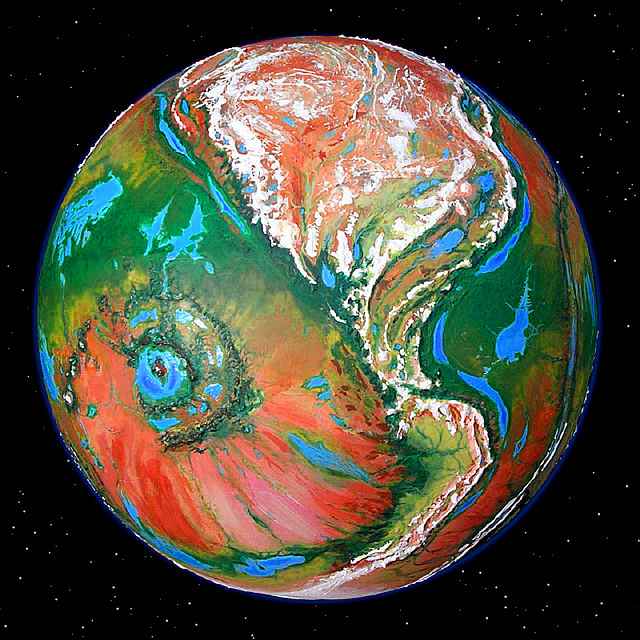 But it's confession time. Those were all excuses! I rigged Tharn to be dry, as a deliberate study in extremes. Peter Ward Douglas (and most exobiologists) emphasize how crucial water is for a biosphere. So I've been exploring a spectrum of world-models, from huge wet Lyr (15 times Earth's water), through several variant Earths like hot wet Dubia (polar meltdown, seas risen 110 meters) and dry Shiveria (glaciation drops the sea level 150 meters), to Pegasia (1/3 as much water--shallow oceans) and Serrana (just 7% of Earth's water, and still fascinatingly fertile), even a terraformed Mars and Venus with shallow seas of mostly imported water... and then there's Tharn. End of the line. Take a Mars, add a little air, tidal-stress it so it's tectonically active. Volcanic CO2 keeps it warm... but dry. Can life evolve, can life flourish, with one-thousandth Earth's water? Yes!
But it's confession time. Those were all excuses! I rigged Tharn to be dry, as a deliberate study in extremes. Peter Ward Douglas (and most exobiologists) emphasize how crucial water is for a biosphere. So I've been exploring a spectrum of world-models, from huge wet Lyr (15 times Earth's water), through several variant Earths like hot wet Dubia (polar meltdown, seas risen 110 meters) and dry Shiveria (glaciation drops the sea level 150 meters), to Pegasia (1/3 as much water--shallow oceans) and Serrana (just 7% of Earth's water, and still fascinatingly fertile), even a terraformed Mars and Venus with shallow seas of mostly imported water... and then there's Tharn. End of the line. Take a Mars, add a little air, tidal-stress it so it's tectonically active. Volcanic CO2 keeps it warm... but dry. Can life evolve, can life flourish, with one-thousandth Earth's water? Yes!
-
"Moonlight" = brilliant. Zeus looks huge--a garish, striped, swirling "moon" a good 10 degrees wide, with nearly 400 times the area of our full moon, and over 1000 times brighter! That's as bright as good indoor lighting on Earth; no silvery moonlight here! Even night-blind humans would see full color at midnight. Instead of mere night and day, there are four light-phases on Tharn: sunlight, Zeuslight, Pegasialight (from 1-12 full moons!), and night--still brightened by the lesser moons, small but brilliant crescents and disks...
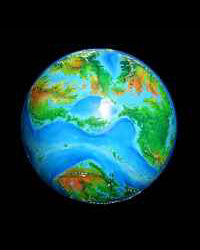
-
Other moons = Zeus has 11 others, but only one matters: Pegasia has half the mass of Earth!. At its closest, a mere 600,000 km inward, it's nearly twice the apparent diameter of Luna. Despite its huge size, Pegasia's not a captured planet but a true moon. Yet it's far more Earthlike than Tharn: dense air (1.6 atmospheres) and oceans with fully 25% of Earth's water. Pegasia, not Tharn, is the richest biosphere in this solar system.
-
Tidal stress = large. Tharn still spins (slowly) relative to Zeus, so both the sun and Zeus play tug-of-war with Tharn's innards. In fact it's a three-way battle with Tharn's huge neighboring moon Pegasia. Zeus alone would create huge oceanic tides--if Tharn had oceans. But even its shallow little lakes have vigorous tides comparable to Earth's oceans.
-
Internal heat and volcanic potential = Earthlike and then some! Conflicting tidal stresses heat Tharn's core and mantle warmer than Earth's, stimulating vulcanism and plate tectonics. It's no Io, but it's hot. And a good thing too. Without it, little Tharn probably would be dead as Mars. Maybe it was, before Zeus captured Tharn and teased it back into life. Or it may have been close enough to the sun (and spinning fast enough, without Zeus's huge drag) so solar tides kept it active and sunlight fed life. Tharn's history as a free planet is long buried, but it's adapted to moonhood. Lunarity? Lunacy?
-
Seas = 6% of surface area, averaging only 30-100 m deep, compared with 3-4 km on Earth. Polar caps, even thinner, cover another 4% on average, varying seasonally. Seas are of three types:
- wide, shallow, marshy salt lakes in the bottom of the basalt basins between rifts and uplands, with shifting, irregular shorelines and many islands
- long, narrow but shallow lakes on the floors of rift zones, like Lakes Tanganyika and Malawi on Earth. Often brackish or mineralized; hotsprings, small volcanoes and strange "vent" communities" on the lake floors.
- long, narrow, relatively deep lakes in the subduction trenches on the edges of uplands. These trenches dip far below the basalt plains; their lakes are like the Dead Sea, but fresher, being largely snowmelt. In the deepest trenches the air is thicker, up to 0.4 atmospheres, creating oases of mild climate where even a Terran might survive.
-
Land (excluding ice) = 90% of Tharn's surface, or 194 million sq km (75 M sq mi)--45% more than Earth! Much of this is marginal, but that's true of Earth too.
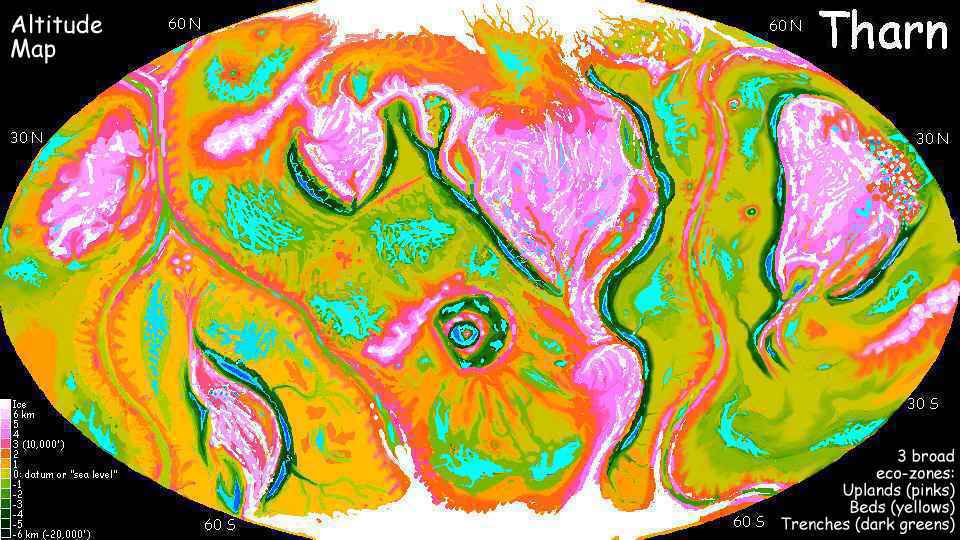
- 79% is lowland, the geological equivalent of Earth's sea floor--basaltic basins with meandering rift zones. These (like the trenches fringing the uplands) often hold long lakes, as in East Africa. Most of Tharn's seas lie in these basalt basins.
- 19% is uplands of lighter "continental" rock (Earth has 30%; Venus, 8%). Unlike Earth (but like Venus and Mars) Tharn's uplands are bulging masses, not neat platforms with clear, sharp continental drop-offs--our deep seas shaped those! Still, there are many offshore trenches (lake-filled), "coastal" ranges studded with great volcanoes, even "island arcs" enclosing dry basins (the nearest Terran equivalents are Ferghana and Tarim Basins in central Asia).
- 1% of Tharn is a different sort of upland--shield volcanoes many km high and hundreds wide. Like Hawaii, these occur in long chains over hot spots in the mantle.
- 1% is subduction trenches, deep gashes where a lowland plate slides under a highland. Air and water collect here; conditions are nearly Earthlike. Biological hotspots!
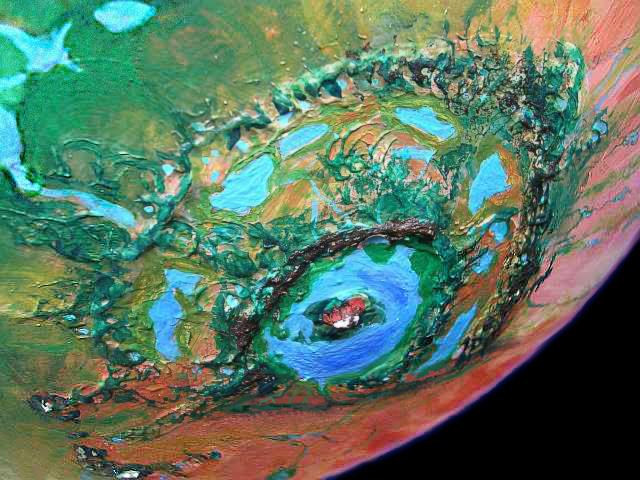
-
Polar caps = currently about 4% of the surface--it varies over time. The ice is not that thick, 500 m at most and usually far less. Near the caps' edges, strata of dust-stained ice create swirling "contour lines" of pink, salmon and rose, as on Mars--though the loudest colors are caused by ice-dwelling microorganisms, not dust. Earth has such "watermelon snow", but not patches bigger than Switzerland.
-
Impacts: One bullseye stands out--it's bigger than Hellas Basin on Mars. Double-ringed like our moon's Mare Orientalis, it's called Heloon. It's nearly 400 million years old. The western third was long ago split off by a rift and buried; the rest has survived, forming a D-shaped arc of mountains and seas. On Earth, wind and rain would have eroded such a crater long ago; but weathering is slower on Tharn, and the crater lies in a desert, so much of it has survived. On the far side of the world, exactly opposite the scar, there's a chaotic upland of snowy peaks and lake-filled basins, formed at impact by shock waves converging round the world, as if Tharn were a great lens. Once twice the height of the Himalaya, they've eroded down to merely Alpine size. There are lesser impact craters, several as large as Chicxulub. A whole chain apparently hit only 10-12 million years ago. Zeus is a real meteor-magnet, and poor Tharn pays the price. However, see above on comets--is Tharn really worse off than Earth?
-
Tectonic activity = vigorous. Internal heating from radioactives is modest, but tidal stress more than compensates. The heat's dispersed both by volcanoes and many active rift zones. The expanding "sea"-floor slips under most "coasts", building high "coastal" ranges with active volcanoes. Three hot-spot volcanic chains larger than Hawaii also rise from the basalt basins.
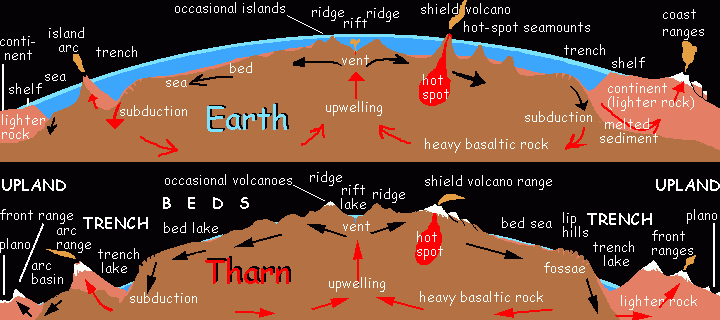
-
Relief = extremely rugged! See altitude map. Low gravity helps, but Tharn's vigorous tectonics push up Himalayan-size ranges at plate boundaries, and huge near-Martian volcanoes rise over hot spots. Mt Tsol, the highest, stands 16.4 km above datum (average level of the shallow seas). (Mars's Olympus rises 26 above datum; Earth's Everest rises 13 km above the Indian abyssal plain). The lowest trench dips 7.8 km below datum, though it's covered by Lake Hoom; the lowest point you can stand on Tharn is Hoom's shore, 7.2 km below datum (Hellas Basin on Mars is 8 km below datum, and our Mariana Trench dips 7 km below the Pacific floor).
-
Atmospheric chemistry = nitrogen 65%, oxygen 21%, argon 9%, neon 4.4%, carbon dioxide, 0.6%. Of course, it's no coincidence the air is fairly Earthlike on a living world. Life does that! I'm not pushing an extreme Gaia hypothesis, in which life deliberately generates an optimal envelope for itself (Earth's isn't optimal, after all--we have big dead zones.)
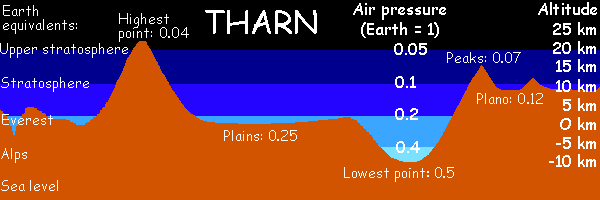
-
Air pressure at datum = 180 bars, or 0.24 Earth atmospheres. Thin, but not Mars--it's dozens of times denser. The partial pressure of oxygen is 26-27% of sea level on Earth--like the air atop Everest. Even Terran life could adapt (geese crossing the Himalaya have been spotted at 30,000 feet). And air pressure varies! In Tharn's deep trenches it's nearly half an atmosphere, comparable to Tibet or the Alps; quite breathable. But in some uplands it drops to an eighth or less: quite fatal to Earthlings.
-
CO2 = 6000 parts per million, or 0.6%. Way more than Earth, though still less than Mars. Without it, Tharn would be frozen. It gets more sunlight than Mars, of course, and has other greenhouse gasses Mars lacks (water vapor, methane, etc.), but even 0.6% of Tharn's modest atmosphere is several times Earth's total CO2--and it's vital! What's the source? Heavy tidal stress keeps Tharn's volcanoes more active than Earth's, and Tharn's seas and modest forests are too small to absorb it all. And this high level is stable. The feedback loop: when CO2 rises, the climate warms, ice melts, and the seas expand. Rain increases, forests and grasslands spread, and the rain weathers rocks more. All this locks up CO2 again. Low CO2 causes an ice age. As the polar caps grow, seas shrink, starved... and deserts spread. With less living vegetation or rain-weathering of rock to absorb CO2, levels rise again. Earth differs a bit: during ice ages, forests do die and deserts increase, but dust and glacial silt fertilizes seas that are nutrient-starved in warmer eras. Basically, while land plants die back, releasing CO2, the seas bloom, sucking up CO2. Life's net effect is less, so on Earth inanimate factors dominate the CO2 feedback loop: shifting currents, precession, volcanoes, and the weathering of new mountain ranges. But on Tharn, cooling causes a real die-back, releasing CO2--and eventually the ice melts.
-
Temperature averages 290 K (17 C, 63 F) on the plains--quite Earthlike! The trenches average 300 (27 C, 81 F) and get up to 320 (47 C, 117 F), but the uplands average 275 K (2 C, 36 F), though the eccentric orbit guarantees summer thaws and winter freezes.
-
Sky color varies, depending on air pressure and dust levels. Deep indigo in the highlands (with stars at noon), rose to lavender over deserts, salmon to gold over savannas, jade-green paling to white over most forests, and pale blues over the larger seas. Sunsets tend to be bloody extravaganzas worldwide, due to fine dust. At night, the sky turns indigo or purple, not black, and stars are few--seen only when the sun, Zeus and the giant moon Pegasia are all below the horizon.
-
Cloud cover = far less than Earth on average. All those deserts!
-
Albedo (reflectivity) = Few clouds, but the deserts and upland icefields reflect more light than Earth's more extensive seas. These factors roughly cancel out--Tharn's albedo in visible light resembles Earth. In infrared, though, this is overwhelmed by the strong greenhouse effect.
-
Climate zones = Like Earth, Tharn has three great convection cells
- a tropical zone with damp rising air, fading to a drier monsoon zone away from the equator
- temperate zones, dry around thirty north & south, but rainy at higher latitudes up to sixty degrees
- dry, cold polar zones past sixty north
-
Air loss over time = significant. Back when Tharn was a free planet, and even for a long time after capture, the sun was dimmer (most stars slowly brighten with age), and the only frost-free lands were equatorial. The denser air helped. So did Zeus's heat--for eons its nightside still glowed visibly red, a hot coal in the sky. As Zeus cooled and the air thinned, the sun slowly warmed, and seas bloomed.
-
Age = 8 billion Earth years. Life began deep in the rift lakes, and only crept up slowly to the unpromising surface, seeking unfrozen seas. The land took a couple of billion years extra to conquer. 400 million years ago, a huge impact wiped out most multicellular organisms on land; for 30 million years, no land species reached a meter in length. But then, Tharn has time for setbacks: its sun will outlast Sol by 5-10 billion years!
-
Total biomass = 15% of Earth's--but remember, Tharn is small. The average density is higher, 33%. In the uplands it's 10%; in the lowlands 35-40%; in the trenches and seas, 50-150%!
-
Habitat diversity = high. The seas range from fresh to saltier than Earth's (and siltier). Most land is desert, but there are extensive savannas, equatorial forests and thinner boreal forests. The uplands are thin-aired Tibets, mostly cold deserts, but grassy altiplanos nearer the equator. The subduction trenches are oases of almost Terran mildness, where life probably emerged onto land.
-
Biodiversity = high. Each sea and trenchlake is an isolated Petri dish, cooking up new species! Life from many such glorified puddles independently colonized the land, with wildly diverse body plans and blood chemistries. No single group dominates.
-
Intelligent species = 13. The trench-seas support amphibious reef dwellers and winged, diving fishers; the tropical woods shelter fructivorous and omnivorous arboreals and fliers; grazers and predators roam the savannas and deserts; mammothlike giants graze the tundras. See Peoples of Tharn.

-
Nomenclature = large features have names adapted from Edgar Rice Burroughs' pulp version of Mars, which Tharn slightly resembles (well, it echoes many early Marses, from C.S. Lewis through Bradbury. But those better writers didn't coin many names). I've named lesser features in the languages of the dominant local species--where it's physiologically possible, I've tried to make their names echo ERB's loopy style, both sonorous and silly. The gazetteer indexes and credits all placenames.
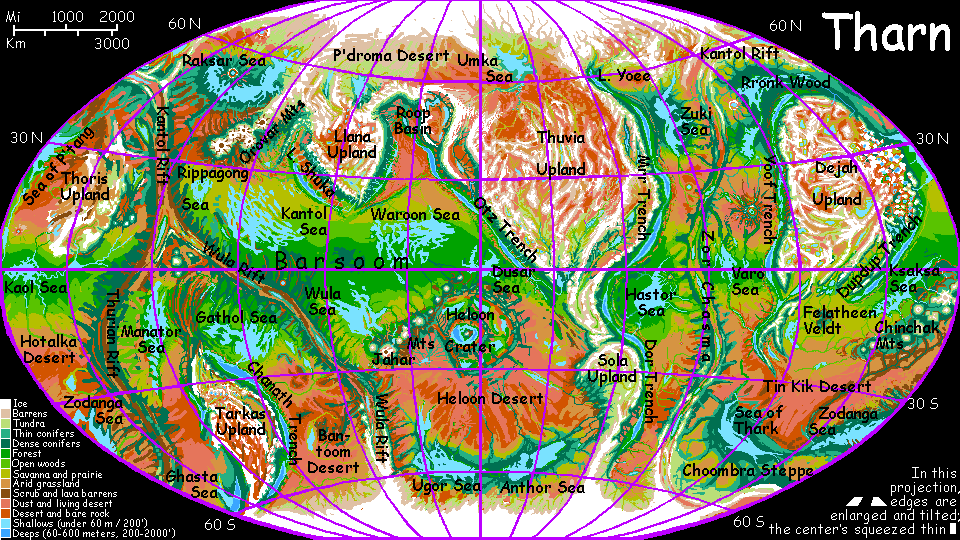 Gazetteer: index of place names with descriptions. Or
TOUR THARN! The following route snakes around Tharn, covering all major features
Gazetteer: index of place names with descriptions. Or
TOUR THARN! The following route snakes around Tharn, covering all major features
Tarkas Upland -- Tars Triangle -- Thoris Upland -- Raksar Sea -- Llana Upland -- Barsoom Basin -- Jahar Range -- Heloon Crater -- Heloon Desert -- South Pole -- Sola Upland -- Otz Trench -- Thuvia Upland -- Mrr Trench -- Far North -- Rronk Woods -- Parthak Crater -- Hastor Sea -- Varo Sea -- Yoof Trench -- Dejah Upland -- Dupdup Trench -- Felatheen Veldt -- Chinchak Mts -- South Seas -- Polodona Wood -- Sea of P'Tang
LISTS AND LINKS: more world-models:
Planetocopia - dreams of
other worlds -
ecology -
climate -
hot & cold-
evolution -
anarchy &
utopias -
sculptures & 3D art
World Dream Bank homepage - Art gallery - New stuff - Introductory sampler, best dreams, best art - On dreamwork - Books
Indexes: Subject - Author - Date - Names - Places - Art media/styles
Titles: A - B - C - D - E - F - G - H - IJ - KL - M - NO - PQ - R - Sa-Sk - Sl-Sz - T - UV - WXYZ
Email: wdreamb@yahoo.com - Catalog of art, books, CDs - Behind the Curtain: FAQs, bio, site map - Kindred sites
THARN
THARN